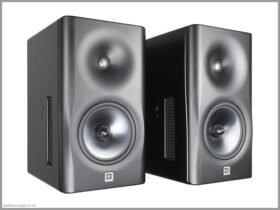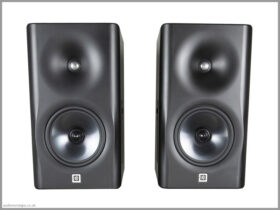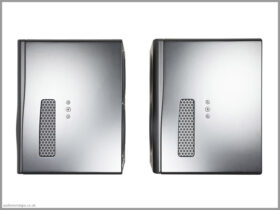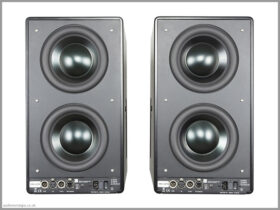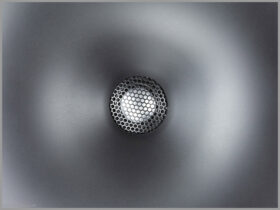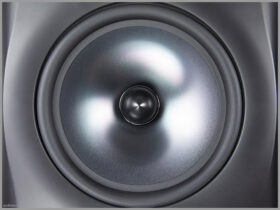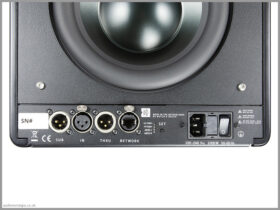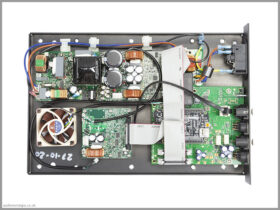TABLE OF CONTENTS
MY STORY
When I started my HiFi journey back in 2005, the Dutch & Dutch 8c did not even exist. At the time, I did not know much about loudspeaker design or psychoacoustics, but I had a great deal of respect for the scientific method and truthful sound reproduction. I’ve tested a lot of different gear in my listening room since then, and this has lead me to a realisation that the two things that impact the sound the most are: (1) the speakers, and (2) the room they are placed in. This is of course based on the assumption that the rest of the equipment is of a decent quality. This is also the reason why I rarely change the equipment but I frequently experiment with different loudspeakers.
There has been a lot of research in the last 40 years, around loudspeaker design, how we hear, and what loudspeaker parameters corelate with subjective preferences (have a look at the Bibliography section of my website if you are interested). In short, in controlled blind tests, overwhelming majority of listeners prefer loudspeakers with the following traits:
(1) even frequency response on-axis,
(2) even frequency response off-axis (aka controlled directivity),
(3) extended low end.
Even though this research is well documented, there are a lot of manufactures that pay very little attention to it, and produce (often quite expensive) loudspeakers with rather questionable design choices.
Luckily, there are new companies entering the HiFi market which base their designs on objective evidence rather than audio voodoo or marketing. One of these companies is Dutch & Dutch. The company is relatively young and at the time this review is being written, they only make one model of loudspeakers – the 8c. Despite them being relatively new to the game, their design embraces most of the academic research conducted to date, with Dutch & Dutch 8c, having extended low end, and extremely even on and off-axis frequency response. Not to mention a few other neat tricks which I’ll talk about more later in this review.
I came across Dutch & Dutch 8c a few years back on Erin’s Audio Corner YouTube channel, and I was rather impressed with what I saw. However, at £13k per pair, they are not exactly budget speakers, and finding them second hand in the UK is next to impossible. Fast forward a couple of years, and I’ve managed to source a pair from a gentleman in London, who works as a professional sound recordist, and used these in his home studio. I paid a little more than I was originally budgeting, but after talking to the owner, I knew they were well looked after so I was happy to pay extra for the peace of mind.
Now the question is – are Dutch & Dutch 8c good enough to replace my current rig (Magnepan 1.7i + 2x Monolith 10 THX + Dirac)? Read on…
SPEAKER INFO
This chapter is going to be rather long and technical because the Dutch & Dutch 8c are very interesting speakers, and being completely honest, I’m fascinated by their design.
Company
Dutch & Dutch was created in 2014 as a spin-off from a Dutch engineering firm. The business was involved in various projects for the professional market. These included extensive research related to localized sound control, digital filters, and sound dynamics. Learnings from these projects sparked an idea of creating a Dutch & Dutch branded loudspeaker, that would employ the latest technology. Dutch & Dutch 8c was the second reiteration of their first speaker, Dutch & Dutch 8m. Both speakers were similar constructions, however, the 8c gained two subwoofer drivers on the back, which made it a truly full-range loudspeaker. As the demand for 8c far exceeded the demand for 8m, the company decided to concentrate their efforts on the 8c, and discontinued the production of the 8m.
Design
With the background out of the way, let us explore what the Dutch & Dutch 8c are all about. Here we have an active 3-way speaker with a built in DSP and streaming capabilities (please note that the reviewed Studio version does not have a built in streamer).
Each speaker features two drivers at the front – a 25mm (1″) aluminium-magnesium dome tweeter housed in a waveguide, as well as, a 200mm (8″) aluminium cone midrange driver. The front baffle is very smooth and does not have any protruding screw heads or sharp edges that could cause diffractions. On the back of each speaker, we have two 200mm (8″) high excursion aluminium cone woofers. All of this is housed in a very rigid sealed enclosure. The crossover is executed in the digital domain using 4th Order Linkwitz-Riley filters. The crossover between the two rear woofers and the midrange driver is at 100Hz, whereas, the crossover between the midrange driver and the tweeter is at 1,250Hz. A FIR filter is used to align the phase of the speaker, making it a time and phase coherent device. Because these are active speakers, each unit features three Pascal Audio Class D amplifiers, three Texas Instruments DACs, one Analog Devices DSP, and one Texas Instruments ADC. Have a look at the diagram below which shows the signal flow in Dutch & Dutch 8c speakers.

If you happened to purchase the ‘domestic’ version of the speakers (with a built-in streamer) and your only source of music is streaming, you won’t need any other equipment to play music, just the speakers – very neat! However, this is unlikely to be appreciated by the audiophile community, because it prevents enthusiasts from making tweaks and changing system components. On the other hand, this is visually a very clean solution, that is likely to be appreciated by household members that don’t like the look of numerous metal boxes and garden-hose-sized speaker cables taking over their living area. I’ve always liked big and heavy speakers, but the older I get, the more I appreciate room friendly solutions.
Connectivity
The speakers offer just two types of inputs: (1) Digital AES/EBU or (2) Analogue Balanced, and both of these connections are executed via a singe XLR female socket. This means that you cannot connect both inputs at the same time – you have to choose either analogue or digital. If you use more than a couple of audio sources, you are likely going to need a preamplifier.
I have 5 audio sources in my system, thus, all of them are connected into my preamplifier, and the digital signal from that preamp is then fed to the speakers. It is worth noting that neither AES/EBU nor XLR analogue connectors are common in domestic equipment. As such, you may find yourself having to convert the signal before you can send it to your 8cs. In my case, I had to use an impedance transformer (Neutrik NADITBNC-M) to convert the digital SPDIF Coaxial output from my preamp into a digital AES/EBS signal. This is of course all doable, but it would have been nice if Dutch & Dutch 8c had more inputs found commonly in domestic equipment (i.e. SPDIF TOSLINK, SPDIF Coaxial, HDMI, Analogue RCA).
My preamp has analogue balanced (XLR) outputs too, so I could have used these to feed the 8cs, however, I did not really see much point in introducing unnecessary digital-to-analogue (my preamp) and then analogue-to-digital (speakers) conversions. After all, with the exception of the turntable, all my sources are digital, thus, it made sense to keep the signal in that format until in reaches the DACs in the speakers. I’ve put together a little diagram to illustrate the signal flow in my setup.

It is also worth noting that each speaker has to be connected to your router via Cat 5 Ethernet cable. This connection is required for the streaming feature, as well as, for you to be able to control the speakers using the Ascend mobile app provided by Dutch & Dutch. Luckily, my router is in the same room as my HiFi gear, and both Ethernet ports on it were unused when I bought 8cs. However, if this wasn’t the case, I would have had to heavily rethink the whole setup. Because I don’t have the streaming capability in my Studio version of the speakers, and I use my preamp to control their volume (speakers are set to fixed gain), I could potentially use them without the router connection. However, you can only put the speakers in sleep mode using the previously mentioned Ascend app, and all DSP preset changes have to be done through the app too. As such, the 8cs are definitely designed to be connected to your local network via Ethernet Cat 5 cables.
It would have been great if they had WiFi instead of just a physical cable connection, as this could be a limiting factor for some customers. It would also be great if the speakers had a ‘Sleep’ button on them, that would allow you to put them to sleep without interacting with the mobile app.
And speaking of the sleep mode, Dutch & Dutch purposely calls it a ‘Sleep’ mode and not ‘Standby’ mode, because this mode does not meet power consumption requirements set by the European Union. EU requires devices offering ‘Standby’ mode to consume no more than 0.5W. Each 8c speaker consumers 7W in ‘Sleep’ mode and this is due to the speakers having to support local network connection for their operation. Personally, I think this is very reasonable, but if you feel particularly green, you can always turn the speakers off using the switch next to the IEC plug on the back of each speaker. Moreover, it is also worth noting that 8cs use Class-D amplifiers, which are far more energy efficient than any other amplifier topologies commonly used in our hobby. Thus, whatever little energy has been consumed in the ‘Sleep’ mode, it will quickly be off-set by how efficient the amplifiers are once you start using the speakers. On the other hand, I don’t think many audiophiles even consider things such as efficiency or power consumption – if they did, there would be very little demand for valve amps or class A transistor amps.
Technology
Before we dive into what makes Dutch & Dutch 8c so interesting, let’s make sure we’re on the same page regarding sound reproduction in rooms. Providing that all other equipment is of a good quality and that the loudspeakers have been competently designed, the room and the speakers placement have by far the biggest impact on the sound we hear. This is because what we hear in rooms is not only direct sound radiated by the speakers, but also the indirect sound reflected from the walls around us. Hence, it is important for the speakers to project similar tonal balance forward (i.e. on-axis) to the tonal balance they project in other directions (off-axis). Unfortunately, this is not easy to achieve and a large majority of loudspeakers in the market do not meet this criteria. This is why, you often hear loudspeaker designers talking about ‘voicing’. This process should involve balancing the on-axis and off-axis sound to create the most neutral sound at the listening position, where the direct and indirect sounds meet our ears.
The Dutch & Dutch 8c have a very similar tonal balance on-axis and off-axis, which means that the direct sound reaching our ears will be similar in character to the reflected sound in the room. As a result of this, no voicing was required during the design of the 8cs. I’ve put together these very crude drawings below, just to visually show the differences that I’m trying to describe here.


There are multiple factors that contribute to Dutch & Dutch 8c having smooth and flat off-axis frequency response. Predominantly, it is a result of using a waveguide on the tweeter which has a similar diameter to the midrange driver. This allows the tweeter to play much lower frequencies than would have been possible without the waveguide, which in turn allows it to be crossed-over at a frequency where it’s sound dispersion with the waveguide is similar to the dispersion of the midrange driver. This creates a smooth transition between the two drivers. There are of course other factors that contribute to this behaviour, such as, high quality drivers and the use of DSP to create relatively steep crossover slopes.
However, there is one more factor that heavily contributes to the 8cs smooth dispersion… it’s their cardioid design, and it is probably their biggest unique selling point. But before we dive into what that means in practice, let’s first explore how the low frequencies behave. If you have not studied acoustics, you may be forgiven for not knowing that dispersion of sound waves is different depending on the frequency and the size of the loudspeaker driver that reproduces it. In short;
- If the sound wavelength is shorter than the diameter of the driver reproducing it, then the driver will project this frequency forward (i.e. like a beam of a flashlight).
- If the sound wavelength is significantly longer than the diameter of the driver reproducing it, then the driver will disperse this frequency in all directions (omnidirectionally).
I find the latter point a little difficult to imagine, however, we can use the analogy of a stone being dropped in the water and the waves propagating in all directions – this is how loudspeakers disperse the low frequencies (but in 3D). It is because low frequencies are really long. For instance, the 100Hz wavelength is 3.43m long – this is significantly longer than a diameter of any subwoofer driver that I have ever seen! For the sake of accuracy, the actual frequency below which the loudspeaker becomes omnidirectional will be affected by many things, such as driver diameter, cabinet size and shape, and crossover point. However, to give you an indication, we can say that most loudspeakers become omnidirectional below 500Hz.
This is the reason why traditional speakers are recommended to be placed far away from the wall behind them (aka front wall). Placing them like this ensures that the sound projected backwards and then reflected from the wall behind the speakers, is delayed enough for our ear-brain mechanism to perceive it as a reflected sound. If you were to put a typical speaker close to the front wall, the sound projected backwards and then reflected from the front wall would be too close in time to the direct sound of the speaker, resulting in our ear-brain mechanism perceiving it as ‘interference’ with the direct sound. This is one of the reasons why typical speakers produce much better soundstage illusion when they are moved further into the room.
In contrast to typical speakers, with the exception of the lowest bass, Dutch & Dutch 8c project most of their sound energy forward, in a cardioid pattern (a half-sphere figure – google it). This sound dispersion pattern is due to the purposely designed vents on the sides of each speaker cabinet. These vents are connected to the enclosure behind the midrange driver. They project the sound sufficiently delayed and in inverted polarity, to cancel the backward sound that comes from the front of the midrange driver.
I’ve tried to illustrate this difference in sound dispersion between a typical speaker and 8c using the drawings below. The black pattern are the first sounds emitted by the speaker, whereas the red pattern are the reflections.


As you can hopefully see, a typical speaker will project the upper bass and lower midrange omnidirectionally, creating the reflections from the wall behind it. Cardioid speakers, such as Dutch & Dutch 8c, will project most of the upper bass and lower midrange forward, preventing a large majority of reflections from the wall behind the speaker.
Why is this important you may ask… well, for two reasons. First, this makes the speakers more precise, as it eliminates most of the front wall reflections smearing the sound. Second, it allows you to put the speakers very close to the front wall, without any detrimental impact on the soundstage illusion. This may not be a big deal to people with dedicated listening rooms, where having speakers more than a 1m away from the front wall is not a problem. However, for people with HiFi in their living rooms (i.e. myself), having a less intrusive setup is always a plus.
But wait, there is more! Being able to place 8cs close to the front wall, allowed Dutch & Dutch to take advantage of another interesting phenomena called boundary coupling. Boundary coupling is an acoustic effect where the amount of bass is increased as the bass source gets closer to the reflecting boundary. You may intuitively understand this when moving speakers around. Quite often, when you put typical speakers close to the front wall, you get a lot more bass output. If the loudspeakers are designed to be placed further into the room (as the large majority of speakers are), this may cause excessive amount of bass being produced. However, when typical speakers are put further into the room, due to the omnidirectional nature of bass, they create bass reflections from the front wall. These reflections then meet with the direct sound, oftentimes resulting in destructive interference which negatively impacts the bass propagation throughout the room.
In contrast to this and thanks to their cardioid dispersion, Dutch & Dutch 8c are designed to be placed close to the front wall. The two woofers on the back of each speaker couple with the front wall and reproduce the bass up to 100Hz. This not also increases the low frequency headroom by up to 6dB, but it also makes the bass more directional. I’ve put together these two drawings in an attempt to illustrate this behaviour:


By coupling with the front wall, Dutch & Dutch 8c make the wall behind them your bass ‘source’, mitigating most of the destructive interference which normally would be created by the front wall reflections. Historically, this type of bass management approach has been reserved for professional studios, with budgets high enough to afford soffit-mounted loudspeakers. Now, thanks to clever engineering and DSP, we can take advantage of this approach at home. I’ve mentioned DSP because it plays a fundamental role in the boundary coupling. DSP is used to time align the front-wall-coupled bass with the output of the drivers at the front of the speaker, creating a time coherent ‘point source’. It is also used to reduce the bass output of the woofers as they get closer to the boundaries. This ensures balanced in-room frequency response.
But what does this mean in practice you may ask… well, you can read my listening impressions below for that. However, from the objective performance point of view, we get relatively small speakers capable of going down to 20Hz (in room) with the output level sufficient for most domestic environments – very impressive!
And speaking of impressive, the previously mentioned DSP is also used to further enhance the performance of these speakers. It is also used to reduce the amplitude of the driver ringing outside of their working range. For instance, the midrange driver is crossed over at 1,250Hz which is significantly below its breakup modes which start above 4,000Hz. With a low crossover point and steep crossover slopes, you wouldn’t think that these breakup modes would have any impact on the loudspeaker performance. However, according to the tests conducted by Dutch & Dutch, targeting these breakup modes with precise PEQ filters makes the speakers easier to listen to and not fatiguing long term.
Overall, after carefully exploring choices made by Dutch & Dutch, I’m blown away by the design of the 8cs. The amount of clever engineering that went into these loudspeakers is truly impressive! I particularly like how resolving one technical challenge has led to their ability to address another (i.e. cardioid design allowed the speakers to be placed close to the front wall, which in turn when combined with DSP, permitted them to take advantage of the boundary coupling effect).
Based on our current understanding of acoustics and psychoacoustics, Dutch & Dutch 8c objectively meet all criteria for excellent loudspeakers:
(1) 8cs have a very even frequency response on-axis,
(2) 8cs have a very even frequency response off-axis,
(3) 8cs have an extended low end.
If the 8c is the first loudspeaker design from Dutch & Dutch, I cannot wait to see what they are going to come up with in the future!
DUTCH & DUTCH 8C SPECS
| Frequency Response: | 35 – 20,000Hz (+/- 1.5dB) -6dB at 20Hz |
| Sensitivity: | N/A |
| Impedance: | N/A |
| Analogue To Digital Converter (ADC): | Texas Instruments PCM4202 |
| Digital Signal Processor (DSP): | Analog Devices ADAU1452 |
| Digital To Analogue Converters (DAC): | 3x Texas Instruments PCM4104 |
| High Frequency Amplifier: | Pascal Audio S-PRO2 Class D 250W |
| Mid Frequency Amplifier: | Pascal Audio S-PRO2 Class D 250W |
| Low Frequency Amplifier: | Pascal Audio S-PRO2 Class D 500W |
| High Frequency Driver: | Seas 25mm (1″) Aluminium-Magnesium Alloy Dome |
| Mid Frequency Driver: | Seas 200mm (8″) Aluminium Cone Midrange |
| Low Frequency Driver: | 2x Wavecor 200mm (8″) Aluminium Cone Woofer |
| Crossover Frequencies: | 100Hz & 1,250Hz |
| Enclosure Type: | Acoustic Cardioid |
| Enclosure Dimensions (HxWxD): | 485x270x380mm (19×10.5×15″) |
| Weight: | 26kg (each speaker) |
| Production Years: | 2018 – Current |
| Price When Launched: | Studio Version £11,500 for a pair Domestic Version £13,000 for a pair |
LOOK & FEEL OF DUTCH & DUTCH 8C SPEAKERS
Taste is a very subjective thing, and I personally was never too keen on the look of Dutch & Dutch 8c. I don’t like speakers with greater depth than width. These type of speakers look out of proportion to me, and unfortunately 8cs fall into this category. Moreover, I do not particularly like the finishes offered by Dutch & Dutch – black or white ABS fronts with oak cabinets just don’t do it for me. It is as if Dutch & Dutch tried blending traditional with futuristic. In this regard, I much prefer the styling of Kef speakers, such as LS50 Meta in white – they went futuristic all the way, and it seems to work really well. The pair of 8cs I purchased is the Studio version, and as such, it has a smooth black cabinet with black front baffle. I don’t find it particularly attritive either, but it is what it is. At this price, I am not only expecting a great performance, but I want to be able to say “Wow, these are pretty!” every time I look at the speakers. However, as I already mentioned – taste is a highly subjective thing.
Enough about styling though – let’s talk about the construction. This is where the Dutch & Dutch 8c shine. Their enclosures are very sturdy and they are put together very well. The outer part of the ‘domestic’ versions of the speakers is constructed from 19mm solid oak wood, whereas the inner part is constructed from 18mm birch plywood. In the reviewed ‘Studio’ version of the speakers, both outer and inner parts are constructed from MDF. Nothing rattles, and the very substantial weight of 26kg for each speaker gives an impression of a quality product.
The only (and a very minor) criticism regarding cabinet work is the finish quality of the holes for the cardioid vents. In some parts of the inner edges of the vents you can see the MDF texture poking through the paint. It is as if the person finishing cabinets could not be bothered to sand these, and they ended up not as smooth as the rest of the enclosure. I totally get that I am being very picky here, however, these are £11,500 loudspeakers, and as such, I’d expect everything to be top notch. And speaking of minor annoyances, the power switches next to the IEC plugs make a crackling noise when turning the speakers on and off. The speakers are 2 years old, thus, I’d be very surprised if the switches have worn-out this quick. On the other hand, I bought these speakers second hand, so I’m going to give Dutch & Dutch the benefit of the doubt here. It is worth noting that the switches are easy to purchase (Schurter DD11.0111.1110) and easy to replace too. Thus, if your speakers are out of warranty and you don’t mind playing with electronics, then it is a 10 minute job.
Drive units in Dutch & Dutch 8c are sourced from SEAS (Norway) and Wavecor (China). Both of these are well respected manufacturers of OEM drive units. The speakers do not come with any fabric grilles, however, with rigid aluminium woofer and midrange cones, and metal mesh protecting the tweeters, the drivers are unlikely to get damaged by ‘curious fingers’.
The day-to-day usage of the speakers is generally a pleasant experience. Even though the Ascend app is rather utilitarian in its design, it is simple to use and gives you a great level of flexibility. One thing that I was slightly disappointed to ‘see’ was the hiss coming out of the tweeters with nothing connected to the speakers. After using my NAD C298 based on the Class D Purifi modules, I got accustomed to hearing nothing from the tweeters. Don’t get me wrong, the noise from the 8c tweeters is not audible from more than 1m away, so it is not detrimental to your enjoyment of quiet music passages. However, I would much prefer for it to not be there at all. And speaking of annoying things, the integration with REW can be quite temperamental. In my case, on number of instances REW could not find the 8c speakers, despite being able to do so before. So it would be good if Dutch & Dutch together with REW ironed out these software glitches as this can lead to a rather frustrating experience at times.
Overall, despite some minor challenges, the finishing quality and the overall user experience when using 8c speakers is at a high level.
SETUP OF THE DUTCH & DUTCH 8C
Speaker Placement
In contrary to traditional speakers which have to be placed far from wall boundaries to achieve decent soundstage illusion, Dutch & Dutch 8c are designed to be placed within 10cm to 50cm from the wall behind the speakers and at least 20cm from the side walls. It is also worth noting that due to their very even dispersion they can be setup parallel to the side walls or towed in, without affecting the level of the direct sound that reaches our ears. Keeping them parallel to the side wall will increase the amount of reflections vs direct sound, and towing them in will reduce the volume of reflected sound vs direct sound. This in my room translates to the sound stage being a little more pin-point with the speakers towed in, and somewhat broader but not as focused with them being setup parallel to the wall. It is all a matter of preference and I ended up with speakers slightly towed in, as per the diaphragm below.

It is also worth noting that the listening axis for 8cs is just above the midrange driver (265mm from the base of the speaker). My ears are at 1020mm from the floor when I’m sitting comfortably on my sofa, which meant that I needed stands that were 755mm high to achieve a perfect listening axis. Saying that, 8cs have a good vertical dispersion too, which means that you could listen at +/- 15degrees and maintain their sound character. Thus, for my listening position the stands could be significantly lower. One could also experiment with tilting up the speakers. Nonetheless, I ended up making 755mm tall stands that put my ears exactly at the reference axis of the 8cs. If you are interested, you can read about the stand making process here.
Room Matching
The physical setup is not the only thing that is required at this stage. The Dutch & Dutch 8c speakers are controlled via the Ascend mobile app (or a web interface using your browser), which requires input from the user to complete the loudspeaker setup. This can be found in the RoomMatching section of the app, and it consists of 3 areas:
1) Boundaries
This is where you have to enter how far your speakers are placed from the side and the front wall. At this stage you measure to the cabinet boundaries (i.e. distance from the front wall to the back of the speaker cabinet, and distance from the side wall to the side of the speaker cabinet). If you tow in the speakers, you need to measure to the middle locations of the speaker enclosure – please have a look at the example drawing below.
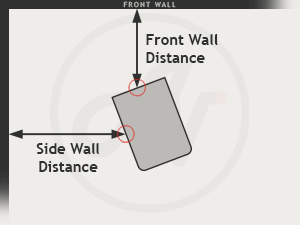
The speaker uses the entered distances in the following way:
- For the front wall distance, the speaker will reduce the bass output the closer to the wall it gets. It will also use the entered distance to time align bass drivers with the output of the drivers on the front of the speaker.
- For the side wall distance, the speaker will reduce the bass output the closer to the wall it gets.
2) Listening Triangle
This is where you have to enter the distance between the speakers as well as the distance between each speaker face and the corresponding ear at your listening position (have a look at the drawing in the SPEAKER PLACEMENT paragraph). The speakers will use these distances to time align the speakers with each other for your listening location. These distances can also be used to correct the balance between the left and right speakers.
3) Room EQ
This is the final part of the setup which requires you to have a fairly accurate USB microphone (does not come with the speakers) and a laptop with the freeware measurement software (REW) installed on it. If you are not familiar with room measurements, this is probably going to be the most challenging part. However, Dutch & Dutch have a very good step-by-step guide on their website. And for people intimidated by this process, Dutch & Dutch also offer a ‘Remote Commissioning Service’, where for £360 you’ll get a MiniDSP UMIK-1 measurement microphone and an online session with a trained professional who will help you tune the 8cs to your room.
I’m quite comfortable with REW and room measurements, so I was quite happy to conduct this process myself. Without diving too deep, the proces involves taking 9 frequency response measurements for each speaker – 1 where your head normally would be and 8 within 30cm (1ft) from this location in different directions. These 9 measurements then need to be averaged and opened in the REW EQ function to generate appropriate filters. Please note that filters can be applied only below 1kHz, and ideally, these should be applied only below Schroeder frequency. This is the frequency below which the sound field is dominated by the reflections in the room. It varies depending on the room size but in most average UK listening rooms is likely to be below 500Hz. These filters are then sent directly to each speaker from REW and can be individually controlled via the Ascend app. Below you can see the frequency responses in my room (with both speakers playing) at different stages of the RoomMatching process.



And voilà – the Room Matching of the speakers is done!
Voicing
If all of the above wasn’t enough, Dutch & Dutch also offers voicing in their Ascend app. This is a way to tweak the sound of the speakers to ones preferences – it is a proverbial ‘salt and pepper’. In contrast to similar features in mobile apps provided with products such as KEF LS60 Wireless, the Ascend app gives a lot more customisable equalisation options. Users can select the filter frequency, gain as well as Q factor. And multiple filters can be applied to each voicing preset. Thus, kudos to Dutch & Dutch for giving users full control as opposed to predefined presets only!
For the purpose of this review, I have not applied any voicing. I did not really feel it was needed but the option is there if one wants to take advantage of it.
SOUND OF THE DUTCH & DUTCH 8C SPEAKERS
First Impressions
Before I started listening to Dutch & Dutch 8c, I was expecting to be greeted with a detailed but rather bright and unforgiving presentation. I’m somewhat biased to expect ‘studio monitors’ to have these kinds of traits. Imagine my surprise when I hooked up these speakers for the first time and they sounded completely different to what I was expecting to hear. The tonal balance of the Dutch & Dutch 8c was just right. No brightness, no harshness or anything of this nature. As a matter of fact, it reminded me of the tonal balance of the Harbeth M40.1 speakers – an easy to listen sound that could be enjoyed for a long time without getting fatigued.
I was also surprised by the bass extension. I knew from the specs that in a room, these speakers are capable of producing full range sound, but experiencing it first hand is a different story. Considering their relatively small size I was really surprised to hear how low they can play, even at high SPL levels. And on that note, these can play very loud without any audible signs of compression or distortion. Yes, if you have a huge listening room and you like it loud, then you’ll need to look for much larger speakers. However, for most domestic environments, your ears will shout ‘stop’ before the speakers do.
There were also two more impressions that I got after the first handful of tracks, and both related to imaging. First one was that the soundstage sounded quite flat (i.e. didn’t have much depth to it). The second one was that phantom images were at the correct height (i.e. above the speakers).
It is also worth noting that I normally test the speakers to give them the best chance of sounding good in my room. Therefore, if a speaker has built in DSP, I see this as an integral part of that design, and I will use it if it is advantageous in making the particular speakers sound good in my room. As such, for the review below, I have applied a couple of PEQ filters to smooth out the frequency response below 1000Hz (this has been described in Step 3 of the Room Matching section in the Setup Process).
After the initial listening session, I spent 2 months with the 8cs as my main speakers. Therefore, my review is based on this period of time spent with them.
Bass
Let’s start with the bass of the Dutch & Dutch 8c as there is plenty to talk about here. It goes deep, very deep! As a matter of fact, in my room it goes flat down to below 20Hz, which is an impressive achievement considering the relatively modest size of the speakers. On songs such as Old Love from the MTV Unplugged album by Eric Clapton, you can easily hear the low level rumble that you don’t get with most speakers. The bass decay is also quite good – it is as if you can hear the tails of the notes for longer, which enhances the overall experience, especially with live recordings.
The bass of 8cs is also tight and ‘meaty’ with great levels of impact. I was playing This Must Be The Place by Talking Heads and it sounded absolutely fantastic. Chest pounding bass and very clear vocals. It is also worth noting that these speakers sound quite effortless – a quality that I’m accustomed to expect from much larger speakers.
What has also surprised me is that 8cs sounded very good at low listening levels, with the lowest bass still present. I was so puzzled by this, that I contacted Dutch & Dutch and asked whether they use some sort of loudness filter, which would increase the amount of bass at quiet listening levels to compensate for how our ear-brain mechanism works (search for Fletcher–Munson curves if you’re interested). Dutch & Dutch have confirmed that 8cs do not ‘automatically’ apply any filters to the audio signal. I’m not sure what makes the lowest bass easier to hear at lower levels, but I really like it. It definitely enhances the involvement during late night listening sessions.
And while we are still on the subject of bass, I wanted to note that the bass produced by 8cs appears to be very balanced across the room. This may have something to do with how the 8cs load the room (see the Technology paragraph in the Speaker Info section of this review). They seem to cause less bass variation across my listening room than most of the speakers that I’ve tested here. Don’t get me wrong, when walking around the room you still have spots where the bass is quieter or louder, but these differences don’t seem to be nowhere near as obvious as with other speakers I’ve tested.
Moreover, thanks to the PEQ filters (mentioned in Step 3 of the Room Matching section in the Setup Process), the bass is very even handed. I’m used to this type of presentation from my current setup (Magnepan 1.7i + 2x Monolith 10 THX Subs + Dirac) with a relatively flat and smooth in-room bass response I was therefore really happy to get that from the 8cs. However, if you are not used to even in-room bass, you may not like this presentation straight away, and depending on your reference, perceive it as lacking in bass, less dynamic, or better controlled and more clearly defined. Nonetheless, once you get used to even in-room bass response, it is rather hard to go back to anything else.
Oftentimes, bass reproduction has more to do with how your speakers load the room rather than the quality of the bass reproduced by the speakers themselves. When reviewers (including myself) describe speakers as sounding boomy, 8 out of 10 times, this impression is a result of the speakers triggering a bothersome room resonance rather than the speakers being incapable of producing quality bass. Good example of that are Spendor A4, which due to the amount of low end they produced, energised my room modes to the levels that made them unlistenable on some tracks. However, during the audition at the HiFi show in a much larger and differently shaped room, they sounded absolutely fantastic.
The opposite of this is also true. When people describe speakers as having great kick or impact, this oftentimes is a result of speakers energising room modes between 80Hz and 120Hz. This can be a very pleasant experience on some recordings but bothersome on others.
All I’m trying to say here is that you can get a very even in-room bass from Dutch & Dutch 8c, but this does not necessary meant that you will appreciate it on all recordings. Well mixed tracks will sound great, but songs deficient in bass will sound bass shy. Good news is that 8cs give you full control over their PEQ settings, thus, you can can modify your in-room response to your heart’s content. You could for example have multiple presets in the Dutch & Dutch Ascend app, and change them depending on what recording your are listening to.
I personally really appreciate the smooth and flat in-room bass response of 8cs. In my listening experience, this has translated to great low end resolution, where I was able to hear details in the bass that I have previously paid very little attention to. There were a number of busy hard rock songs, where I’ve started noticing that there is bass guitar or a double bass in the mix. Sure enough, when I played these tracks on my current setup, I was able to hear these instruments too, but they were not as easy to ‘separate’ from the rest of the mix.
Overall, bass of Dutch & Dutch 8c is probably the best I have ever experienced in my room to date.
Midrange & Treble
Midrange and treble is another area where the Dutch & Dutch 8c excel. I’ve already mentioned in my first impressions that they sound very smooth. That impression has not at all changed. If anything, the more I listen to the speakers, the more I wanted to hear. Songs such as Rich Men North of Richmond by Oliver Anthony are a great example of that. The vocals are sublime, one of the nicest and most truthful reproductions I have ever heard. Every handful of songs I would say to myself “Wow, this vocal sounds so real!”. You hear sibilants but only if they are in the recording. A good example of that is Byłam Różą by Kayah & Bregovic, where the letter ‘S’ is quite emphasised but this is not ‘added’ by the speakers, it is just part of what has been recorded. I have a great deal of respect for Harbeth speakers for their reproduction of vocals (and many other things), but I think these Dutch & Dutch 8c take it to another level. And while we are discussing similarities with Harbeth speakers, it is also important to note that the tonal balance of the Dutch & Dutch 8c is quite forgiving. Even on relatively bright recordings such as Hell Is for Children by Pat Benatar, when things get busy, you can still enjoy the music. This is a contrast to what I’ve experienced with ATC SCM40A for example, which in my room were ruthless with bright recordings. At louder levels, they could make your ears bleed with the above-mentioned track.
Where Dutch & Dutch 8c perform very well too is instrument reproduction. Everything sounds just right. Strings, woodwinds, brass, percussion – you name it. I’ve tried really hard to find something that I would dislike about how these speakers reproduce various instruments and I just couldn’t. If I wanted to be really picky, when I listened to Give Me All Your Love from the Starkers In Tokyo album by Whitesnake, it sounded beautiful but I would not say that the guitar was as prominent as I remember it on the Tannoy Little Gold Monitor speakers. However, we all know how unreliable our auditory memory is, thus without comparing the two speakers side by side, it is rather difficult to have any confidence in these sort of statements. Moreover, all of this goes back to the ‘circle of confusion’ problem, where there are no recording and playback standards. As such, if something was mastered on non linear speakers (i.e. with peaks in certain frequencies), the engineer might have compensated for these issues by reducing prominence of certain instruments in this region. When we then play a recording like this on linear speakers, it may not sound as prominent. It sounds like I’m making excuses for Dutch & Dutch 8c here, but in my experience so far, having accurate speakers does not necessarily guarantee that every single recording will sound great. What it guarantees though is that your speakers are not adding anything to the sounds that you are hearing, that wasn’t there in the first place.
Another interesting thing about Dutch & Dutch 8c speakers is their resolution. This is not something that is easy to notice during the first few minutes, but it becomes very clear over time. Frequently, people use adjectives such as details and transparency when the speakers have elevated treble. These impressions are somewhat understandable, as with more prominence in certain frequencies, you are likely to hear ‘more’. However, this type of presentation is a double edged sword… Although very attractive initially, it quickly becomes fatiguing during longer listening sessions. Transparency with Dutch & Dutch 8c is not like this. They don’t throw the details in your face. Instead, they politely present them in front of you. Their magic is in how easy it is to hear into the recording without the overall sound being fatiguing. When I listen to tracks such as Abyssinean Dub by Blue Asia, with multiple things going on at the same time, the 8cs clearly separate sound sources from each other. It is not that you hear sounds that other speakers don’t reproduce – not at all. But the 8cs make these sounds a lot easier to hear at the same time as everything else. During this review, I have been constantly paying attention to things that previously were just part of the mix. It is rather difficult to put these impressions into words, but I’ve tried to illustrate them with a drawing below.
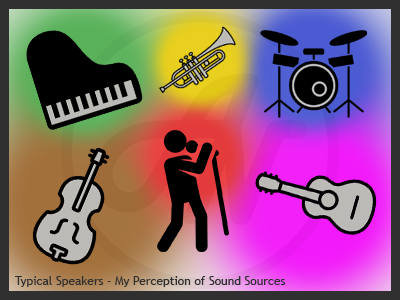

In most normal speakers the sounds from various instruments “pollute” each other, making it difficult to tell different sound sources apart. With the Dutch & Dutch 8c, these sound sources appear to be in their own separate ‘compartments’. You may think that as a result of that, 8cs will sound quite dry. Far from that. The amount of atmosphere within these ‘compartments’ is phenomenal. I constantly get impressions of the location where the recording took place. This is especially noticeable with vocals, where you very quickly get an idea of what type of room they were recorded in.
However, their ability to hear well into the mix takes some getting used to. On tracks such as Nevermind by Leonard Cohen, I was initially distracted by the ‘mouth sounds’ that are on the recording. I actually checked whether I could hear them on my Harbeth P3ESR, and sure enough, I could – they just were more blended in with the rest of the recording. It appears that in some cases, the ability to hear into the recording may become a distraction from emotionally engaging with the music. It is as if your brain has too many stimuli and initially does not know how to handle them. We can use the analogy of a kid in Legoland – he sees so many cool things at the same time, that he doesn’t know where to start.
I was getting a little worried about being so impressed by everything these Dutch & Dutch 8c speakers do. Perhaps because of my knowledge about their design and superb objective performance, my sound impressions were getting skewed? I.e. I was projecting what I wanted to hear?
To sense check my impressions, I’ve invited an audio enthusiast friend, and told him that I was reviewing a set of speakers and I wanted a second opinion. He did not know what the speakers were, he has never heard of Dutch & Dutch, and I’ve told him nothing about their design or their price, to mitigate any possibility of influencing his perception. Unfortunately, my friend likes jazz and baroque vocal with orchestra, which despite my eclectic music taste, are two genres that I get very little joy from. Thus, for over two hours I was tortured with his music selection… but it was worth it. When we finished, the first thing he said is that he loves the treble and described it as very detailed. He also said that he could hear every instrument separately, and that they weren’t all gelled into one lump of sound. My friend has also mentioned that despite lots of details, the speakers were very easy to listen to and not fatiguing. He was also surprised by the bass, noticing that it does not seem to cause any problems in my room. When I eventually then told him what they were and how much they cost, he said “They are worth it!”.
I felt a little relieved having a second and, as far as it is possible, unbiased opinion similar to my own. I now have more confidence that my subjective impressions were a result of well designed speakers and not me subconsciously wanting them to sound good.
Soundstage & Imaging
Contrary to my initial impression of the soundstage being flat, after the first week of living with Dutch & Dutch 8c speakers, that impression has completely gone away. I now perceive their soundstage as relatively deep and behind the speakers. What’s interesting though, the friend I mentioned in the previous paragraph said that his perception was that the soundstage was nicely layered but projected in-front of the speakers. There may be some sort of adaptation going on here, as when I listen to the speakers now, I definitely hear the sounds coming from behind the speakers with clearly defined layers. Perhaps some of the phantom images are not as deep as I recall on the Harbeth M40.1, but this does not stop me from enjoying the performance. Moreover, after experiencing a number of well regarded speakers, I’m beginning to wonder whether the depth I recall from the M40.1s was created artificially by how these speakers were voiced. I’m saying that because with these Harbeths, even some studio recordings sounded as if the main vocals were a couple of meters behind the speakers. This type of presentation can be of course really nice and I personally liked it very much. Whether it s a truthful representation of the recording is another story.
But back to the soundstage of Dutch & Dutch 8c. It not only has great depth but also decent width. A great example of that is Ri Na Cruinne by Clannad, where the drum strikes are not only nicely behind the speakers, but also spread out beyond the speakers on both left and right. Not to mention the well controlled and deep bass. A very impressive and immersive experience. The width of soundstage is of course limited by the width of my room, but based on my experience with other high quality speakers, this is normal.
What is interesting though is how Dutch & Dutch 8c reproduce soundstage height. Most conventional speakers, when you listen to them at the reference axis, present the performance at the same level as your ears. We get used to this, however, this is not very realistic. After all, if you had a band playing in front of you, they are likely standing, and therefore, the main vocals and most instruments should be coming from above your ear height. Dutch & Dutch 8c project most of the phantom images above the speakers, and therefore, above your ear height. I first experienced this type of more realistic soundstage height with Magnepan 1.7i, and then later with KEF LS60 Wireless, and I like this presentation a lot. It contributes to the live recordings sounding as if you were there during the performance.
One thing that surprised me a little though is how small the listening sweet spot in my room is with 8cs. As soon as I move my head left or right, the image shifts with it. I’ve experienced that with most speakers in my room, but strangely it is just easier to notice with 8cs.
Comparison With Other Speakers
Whenever evaluating speakers, it is always good to do some side by side comparisons to verify your impressions. The loudspeakers I used for this purpose are not natural competitors to Dutch & Dutch 8c, but they are well regarded and happened to be speakers I’ve had on hand at the time.
a) Harbeth P3ESR 40th Anniversary vs Dutch & Dutch 8c
Despite both speakers being set at the correct listening axis, the Harbeth P3ESR 40th Anniversary seem to present the voices significantly lower. On P3ESRs, they come from the level of the speakers, whereas on 8cs they appear to be coming form a more natural height. In terms of soundstage depth, Harbeths seem to create a greater depth illusion, and this is noticeable on songs such the acoustic version of Young by Tulisa.
What surprised me though is that the P3ESRs seem more bright. This is noticeable on tracks such as You Don’t Care Enough For Me to Cry by John Moreland with guitars sounding more ‘sparkly’ on Harbeths. This is also noticeable on recordings such as Jolka, Jolka Pamiętasz from the Live At Carnegie Hall album by Budka Sulfera, where guitars are more prominent on Harbeths. However, the very same trait also makes the P3ESRs vocals sound a bit spitty and shouty by comparison to 8cs. The vocals on 8cs just sound more natural. There are also more sibilants present on little Harbeths. On most records I’ve tested, I much preferred the vocals on Dutch & Dutch, but there were some exceptions. For instance, on The Night They Drove Old Dixie Down by Joan Baez, the vocals on P3ESRs sounded nicer than on the 8c. Saying that, during the chorus, all sounds on Harbeths were more blended with each other, whereas on Dutch & Dutch they were just easier to tell apart.
Songs such as Good Life by Brassroots sound a lot more effortless and have much greater bass impact on Dutch & Dutch 8c. The brass instruments also sound more real on 8cs. P3ESRs have a surprising impact and depth of bass for their size. Nevertheless, once the track gets going, the small Harbeths seem not as easy to listen to and more fatiguing (I never thought that I would ever use this adjective about Harbeth speakers!).
Overall, with Harbeth P3ESR you can tell that you are listening to much smaller and less ‘refined’ speakers, however, this did not mean that I preferred the sound of Dutch & Dutch 8c on 100% of recordings.
b) Magnepan 1.7i vs. Dutch & Dutch 8c
Please note that in this comparison I used the Maggies as they were, without subwoofers or Dirac for bass correction. Moreover, due to the room width restriction, I was unable to place the Magnepans in the most optimal position. As such, take my comments as a curiosity rather than gospel.
When comparing Dutch & Dutch 8c with Magnepan 1.7i, the common theme on most tracks was that Maggies sounded more ‘muffled’ than 8cs. On songs such as Ride On by AC/DC the Dutch & Dutch had a lot more air. I believe a lot of this perception may have to do with the bloom in the bass region of the 1.7is. This room interaction could be of course mitigated with placement (i.e. positional EQ) but this wasn’t feasible for the comparison due to the previously mentioned reasons. Strangely though, this room mode caused by Maggies suited some tracks. For instance on Oh Devil by Electric Guest, it gave the track more impact than 8cs. Saying that, even though the 1.7i bass had more ‘volume’ it also was more rounded – you will know what I mean if you have ever experienced a dipole bass. In addition, on 8cs there was a nice low level bass that was simply not present on 1.7is.
And speaking of things not present on Maggies, when the above-mentioned track starts, it is easy to hear the distortion on the 8cs whereas, it is hardly noticeable on the 1.7is.
What’s good however, is that Maggies seem to present the phantom images deeper than the 8cs, however, these images are nowhere near as precise as on 8cs. Moreover, when things get busy, Maggies seem to be more congested for the lack of a better word. This is noticeable on songs such as Wojenka by Lao Che from the Meskie Granie 2016 album, where it is easier to tell apart sounds from each other on the Dutch & Dutch 8c. It is also worth nothing that vocals sound more natural on 8cs and this has been the case with most songs, including the above mentioned one and Lighters Up by Lil’ Kim.
Overall, the Dutch & Dutch 8c are much more accurate speakers than Magnepan 1.7i. They are also a lot easier to setup and live with. However, there is something special in how Maggies reproduce the sound, and if you have never experienced panel speakers before, they are definitely worth a try.
The comparison above was done to not only give you more reference points but also to demonstrate diminishing returns in HiFi. The 8cs are at least 3 times as much as both the P3ESRs and 1.7is, but they definitely don’t give you 3 times as much joy when listening to music. If I invited a random person from the street and let them hear all 3 speakers, I very much doubt they would have guessed that 8cs cost 3 times as much. Also, based on my subjective experience, once you reach a certain level of performance, it is rather difficult to get something significantly better. I’ve reviewed a number of well regarded speakers in my living room, and at no point was I swept off my feet. Sure, with certain designs there were clear improvements, but these were never ground breaking.
I’m simply trying to manage your expectations here. Over the years, after reading rather enthusiastic reviews of various premium equipment, I was expecting to be blown away by it. When I eventually had enough money to buy it, it turned out the improvements were not as ground breaking as I expected after reading the reviews. With the current design of loudspeaker drivers, we are getting pretty close to the technical limits of what is feasible. Unless loudspeaker design changes completely, I don’t believe you should expect ‘significant’ improvements. This challenge is further emphasised by the fact that in the last 10 years, various HiFi manufacturers have caught up with our current understanding of what makes good loudspeakers. There are more and more speakers in the market that offer a great level of performance for relatively affordable prices.
I say all of this to highlight the challenge of perceived value in HiFi. Spending 300% more to get 10% improvement may well be good value to you if you have enough disposable income to afford it. However, if you have to kill yourself working over and saving up to get a piece of new gear because you were sold on this “dream”, it may not be worth it.
Please note that I’m not trying to take away anything from Dutch & Dutch 8c here. These are truly excellent loudspeakers. As a matter of fact, the best ones I have experienced in my room to date. If you can afford them – buy them. I just did… and I’ll be keeping these as my new reference.
BACCH PLUGIN FOR DUTCH & DUTCH 8C SPEAKERS
If the 8cs weren’t cool enough already, the Dutch & Dutch team decided to make them even better by offering an optional BACCH plugin to enhance already excellent stereo sound to something even more three dimensional.
I’m normally very sceptical of anything that interferes with the signal, but knowing how passionate the Dutch & Dutch team is about the sound quality, it would be silly of me not to explore what BACCH is all about.
What Is BACCH
Let’s start with the name… BACCH is an acronym for Band-Assembled Crosstalk Cancellation Hierarchy. Even though the name sounds quite complicated, the idea behind it is pretty simple, at least in principle. But before we dive in, let us first try to understand what the crosstalk is. Crosstalk is a form of ‘sound pollution’ where sound from one channel leaks to the other channel. In the context of the room-loudspeakers setup, crosstalk refers to a situation when listener’s left ear can hear the signal from the right speaker, and listener’s right ear can hear the signal from the left speaker, as per the visualisation below.
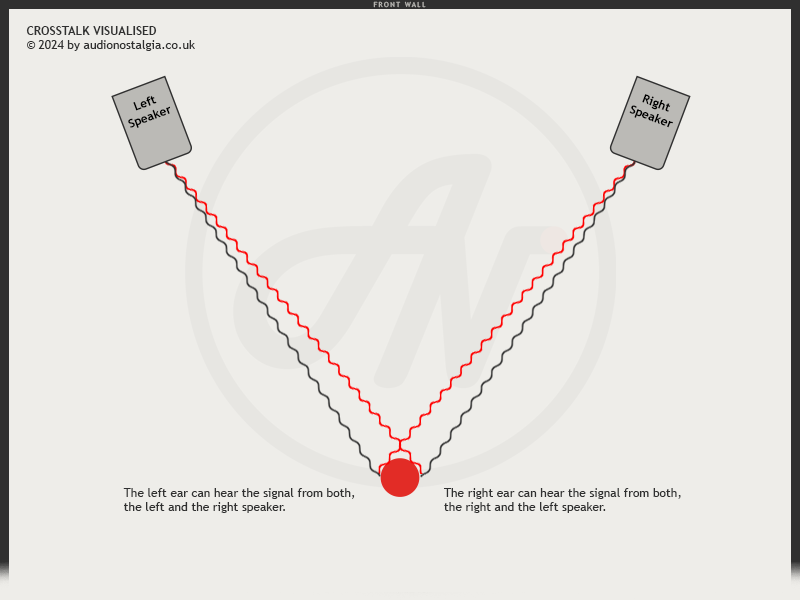
The objective of BACCH is to ensure that the left ear can only hear the signal from the left speaker and the right ear can only hear the signal from the right speaker. We can visualise it by placing an infinitely long absorbent boundary that goes through the middle of the listener – see the image below. This boundary prevents the listeners left ear picking up the signal from the right speaker, and prevents the listener’s right ear picking up the signal from the left speaker, effectively cancelling the crosstalk.
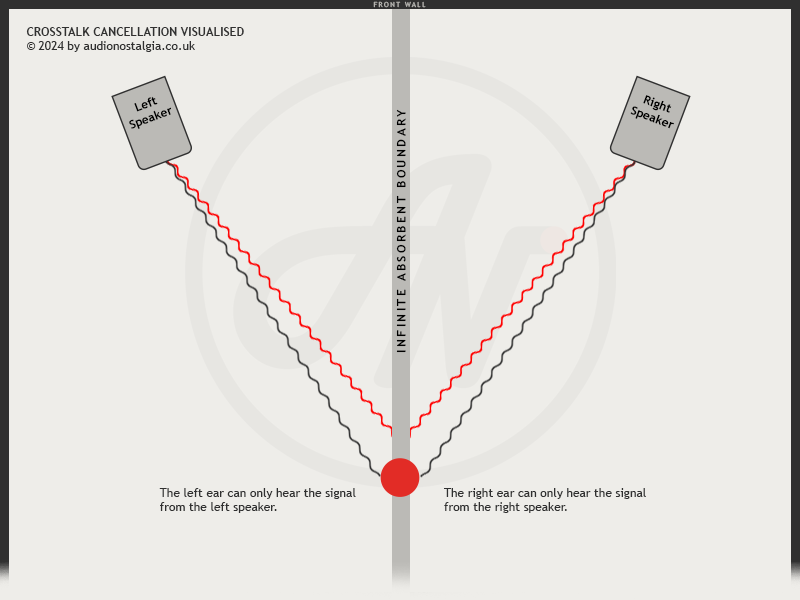
Thus, in principle, the BACCH aim is to convert your rooms-loudspeakers setup to work in a similar way to a pair of headphones. The question is why? The answer to this is a little more complex, but if you got this far in my review, you may as well stay for the ride…
Let’s start by framing how our ear/brain mechanism works to localise sounds in three dimensional space. Two main mechanisms used for this purpose are the volume and time difference of the sound arrival at the left and right ear. I’ve tried to demonstrate this in the drawing below, where we have the listener located centrally in front of the stage (red dot), and the singer being to the right of the stage.
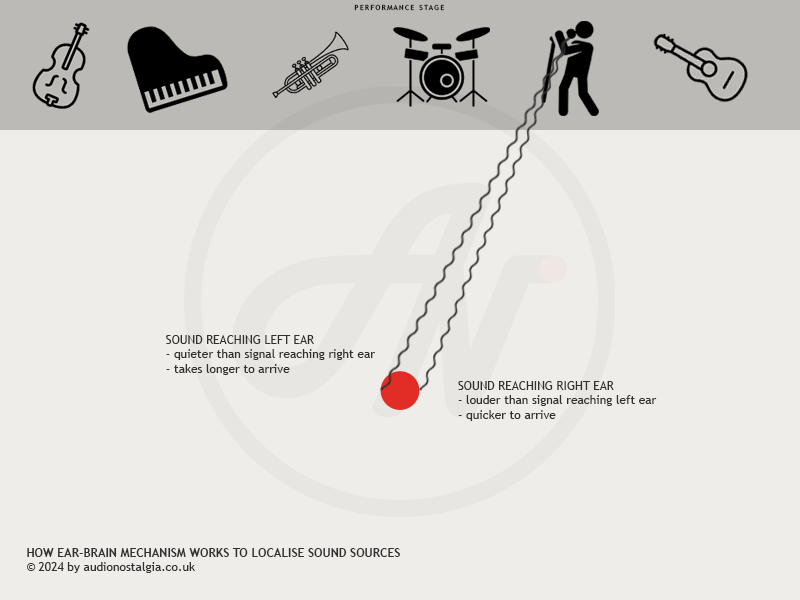
If the listener closes their eyes, they are still able to tell the location of the signer in three dimensional space. This is because the direct sound coming from the singer is heard through both ears. The left ear hears the signal a little later and quieter (because it is further away) and the right ear hears the signal sooner and louder (because it is closer to the sound source). Our brain is using these spacial cues to calculate the location of the sound source in three dimensional space. It is also worth noting that our brain is using the reflections within the pinna (external part of the ear) to determine the location in vertical space (i.e. how high or how low the signer is).
Now we have a basic understanding of how our ear-brain system works, let’s discuss how the music is being recorded. The stereo recording techniques vary depending on the type of music and when it was recorded. In a lot of modern popular music, oftentimes each instrument/vocal is recorded separately in a different location, and then, everything is mixed together by the mixing engineer. At the other end of the spectrum, you have live performances recorded using a ‘binaural’ method, where a dummy head with high-quality microphones in its ears is used (see the visualisation below). The latter is meant to capture the sound in the same way as your ears would if you were attending the performance in person (with all spacial cues that allow you to localise sound sources).

Up until recently, audiophile recordings captured this way could only truly be enjoyed using headphones, where listeners could enjoy a very realistic 3D soundstage illusion. This was only possible because with headphones, the left ear can only hear sound from the left channel and the right ear can only hear sound from the right channel. However, reproduction like this wasn’t possible using speakers, due to the previously described crosstalk.
Loudspeaker crosstalk is nothing new, and various attempts have been made to address this over the years; with mixed results. From what I’ve read, most that were successful at addressing the crosstalk, also negatively impacted the tonality. As such, these have never been widely adopted by the audio enthusiast community. With the significant advances in Digital Signal Processing (DSP) in recent years, the patented BACCH algorithm, promises to address the crosstalk problem without impacting the sound in any other way. It appears that we now can have our cake and eat it too!
BACCH has been developed by Dr. Edgar Choueiri, a Professor at Princeton University, who is passionate about 3D audio.
It can be purchased in various forms. You can get it as a self contained high end processor (BACCH-SP), which you can use with your existing HiFi. This setup comes with a small camera which tracks your head movements, and with high quality in-ear microphones to calibrate BACCH for your setup. BACCH-SP stars from £21,000, with the fully specced model going for over £46,000! At the other end of the scale, we have a way more budget friendly software version (BACCH4Mac), which can be installed on a computer that you use for streaming music, for approx. £800. This of course does not have all the bells and whistles of the BACCH-SP processor, but it does what BACCH was designed to do – mitigates crosstalk cancellation. I suspect that this is also the versions of the BACCH plugin that can be purchased through the Dutch & Dutch mobile app (Ascend) for £780 (€999).
If you have read this writeup carefully, you would have noticed that mitigation of crosstalk cancellation during loudspeaker playback is mainly beneficial if the recording your are listening to was captured using the ‘binaural’ method. According to BACCH FAQ, BACCH should also be beneficial when playing recordings captured using other methods (i.e. spaced omni mics, ORTF, XY), providing that appropriate attention was paid during the recording process. For music not recorded in a real acoustic space (most pop and electronic music), BACCH may enhance the effects created by the mixing engineer. Whether you are going to like these enhancements will be completely dependent on the recording and your preferences.
Why BACCH and 8Cs?
In order for BACCH to work effectively, it requires loudspeakers with very linear on axis response and very even off axis response (smooth directivity). As you will know by now, these are indeed two traits that Dutch & Dutch 8c possess. Moreover, because 8cs have a built in DSP and a mobile app, adding BACCH wouldn’t require any physical changes to the speakers. And voilà, we have a perfect match!
The only caveat is that the BACCH plugin requires both channels to calculate the correct response and apply filters. Dur to this, right now BACCH is only available in the 8cs for streaming audio. In the future, Dutch & Dutch may consider developing it for the AES input too.
BACCH Listening Impressions
In my experience based on listening in my own environment, the impact of BACCH very much depends on how a particular song was recorded. On some tracks it makes little difference, on some, enhances the experience significantly, and on others, changes things in a way that I’m struggling to tell whether I like or not. Good example of the latter is Dancing In the Dark by Eddie Berman, where without the BACCH on, male vocal is placed in centre right of the soundstage and female vocal on the right side of the left speaker. With BACCH on, the male vocal shifts to practically the same location as the female vocal and both are on top of each other. It’s a significant change and in a back to back switching it’s quite disturbing. Neither sounds better or worse, just different.
One thing that is fairly consistent in my perception, is that on most recordings BACCH softens the treble and makes harsh recordings more tolerable, whereas without BACCH things sound more bright and sharper.
Faith by George Michael is a good example of that. With BACCH turned on, I perceive it as softer sounding. With it off, the hi-hats sound more prominent and his voice appears more sharp too. It is as if with BACCH, sharp edges of treble were more naturally smooth. On that particular track, BACCH did not do anything to enhance the overall listening experience for me apart from the treble effect. However, as I’ve been listening to George Michael, and played the I Want Your Sex track, things have become quite different. With BACCH on, the soundstage became a lot wider and a lot more immersive. The clicking synth sound in the left channel moved from the left inner side of the speaker to about 1m outside of it. Very nice!
I had similar impressions with Esposito Da Floresta Amazonica by Cafe, where with BACCH on, an already immersive recording became even more immersive. It is hard to tell exactly why, but with BACCH on, it is easier to hear depth of soundstage and a sense of being enveloped in sound. Similarly to the other songs, it sounded ever so slightly softer with BACCH on.
To my ears, BACCH also gives an impression of more space around the sound sources. Sometimes it is almost as if more reverb was present in the recording. At times it also gave me a hint of sounding phasey. It’s hard to put into words, but if you ever experienced one of the speakers being connected in the inverted polarity, you’ll know what I mean. BACCH of course does not do it to the same extent, but once in a while I get a hint of something phasey in the sound.
It is worth noting that for BACCH to perform at its best, you should either use speakers with narrow dispersion (high proportion of the direct vs reflected sound) or if you are using wide dispersion speakers, the early reflecting surfaces should be far away from the speakers. Horizontal dispersion of Dutch & Dutch 8c speakers is approx. 55° each way, so relatively broad. If you look at the setup of my room above, you will see that my 8c speakers are only 55cm from the sidewalls. It is therefore possible that you can get better results with BACCH if your speakers are further away from the side walls.
One thing that is not room dependent is the fact that BACCH was not created for sharing your listening experience with other people. As such, if you want to listen with a couple of people (all sitting in different spots), BACCH is best turned off. This is of course not a surprise, as BACCH was never designed as a multi seat solution.
The big question is whether BACCH is worth £800 (€999)? That very much depends on how you look at it and your circumstances… I know, I’m not very helpful but hear me out… In my case, most of the music I listen to comes from CDs and BACCH is not yet available for the AES input. Thus, in my circumstances, spending £800 on something I’m going to use a couple of times a year is not going to be worth it.
However, if your primary source of music is streaming, you will very likely look at it differently. In the spirit of keeping it real though, £800 can get you a decent set of second hand bookshelf speakers, and here we have to pay that for a piece of software… On the other hand, people spend crazy amounts on cables and other equipment that often makes very little difference. Certainly in comparison, £800 on something that makes quite significant difference and can be turned on and off with the click of a button is a much better idea. In my experience, BACCH makes a lot more difference than any cable swaps or electronic changes that I have ever experienced. Whether that difference is worth it to you, you’ll have to judge it yourself. Luckily, Dutch & Dutch offer a demo mode, so you can try BACCH with your 8cs before you buy. It’s risk free, so if you already have a set of 8cs, it is most definitely worth a try!
CONCLUSION
Dutch & Dutch 8c are without a doubt the best speakers that I have experienced in my listening room to date. They offer a starkling level of resolution without at all sounding harsh of fatiguing. They sound effortless and are very engaging to listen to. Thanks to the built in DSP capabilities, you can not only tune their bass to your room but also adjust their tonality to whatever your preferences may be. If you want the full range high end sound in a compact package, and money is not a problem, then I would highly recommend Dutch & Dutch 8c.
| Balance of Sound: | |
| Neutrality of Tone: | |
| Transparency: | |
| Soundstage: | |
| Attack: | |
| Engagement: | |
| Total Score: |
SONGS MENTIONED IN THIS REVIEW
AC/DC – Ride On
Blue Asia – Abyssinean Dub
Brassroots – Good Life
Budka Sulfera – Jolka, Jolka Pamiętasz (Live)
Cafe Da Silva – Esposito Da Floresta Amazonica
Clannad – Ri Na Cruinne
Eddie Berman – Dancing In the Dark
Electric Guest – Oh Devil
Eric Clapton – Old Love (MTV Unplugged)
George Michael – Faith
George Michael – I Want Your Sex
Joan Baez – The Night They Drove Old Dixie Down
John Moreland – You Don’t Care Enough For Me to Cry
Kayah & Bregovic – Byłam Różą
Lao Che – Wojenka (Live from Meskie Granie 2016)
Leonard Cohen – Nevermind
Lil’ Kim – Lighters Up
Oliver Anthony – Rich Men North of Richmond
Pat Benatar – Hell Is for Children
Talking Heads – This Must Be The Place (Naive Melody)
Tulisa – Young (Acoustic)
Whitesnake – Give Me All Your Love (Unplugged)
Reviewed: August 2023 | Published: October 2023 | Updated: July 2024


